June 2008 Midwest floods
It has been suggested that Iowa flood of 2008 be merged into this article. (Discuss) Proposed since June 2008. |
This article is about a current flood where information can change quickly or be unreliable. The latest page updates may not reflect the most up-to-date information. |
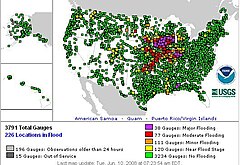 | |
| Date | June 7 - Ongoing |
|---|---|
| Location | Illinois, Indiana, Iowa, Missouri, Minnesota and Wisconsin |
| Deaths | 13 Deaths |
| Property damage | TBD |
On June 4, 2008, severe thunderstorms began to impact the upper Midwest United States. Tornadoes, hail, severe lightning, and rain led to major damage to much of the region. Flash flooding led to the evacuation of thousands of homes in low-lying areas. The situation worsened as rain continued on June 5. Flooding has continued up to June 18. States affected by the flooding include Illinois, Indiana, Iowa, Michigan, Minnesota, Missouri, and Wisconsin. The American Red Cross is helping the victims of flooding and tornadoes across seven states. They anticipate spending in excess of $15 million for recent disasters.[1] As of June 20, twenty levees along the Mississippi River have been breached since flooding began.[2]
Illinois
| Date | June 7 - Ongoing |
|---|---|
| Location | Adams, Hancock, Henderson counties |
| Deaths | 1 Death |
| Property damage | TBD |
On June 11, Illinois Governor Rod Blagojevich deemed Clark, Coles, Crawford, Cumberland, Jasper and Lawrence counties as disaster areas. Levee breaks on June 10 flooded portions of Lawrence County near Lawrenceville, inundating a campsite and forcing the evacuations of 200 homes.[3]
On June 14 many communities located along the Mississippi river in West Central Illinois were notified by the National Weather Service that crests along the river would exceed the record crests of 1993. U.S. Senator and Presidential hopeful Barack Obama (D-IL) visited Quincy, Illinois to help with the sandbagging efforts and to observe the river.[4]
On the early Morning of June 14, the town of Oquawka, Illinois was evacuated, due to a breach in a levee along the swollen Iowa River. It was the belief of the city council that this would affect the flood waters along the already flooded Mississippi River. The same day two levees broke near the town of Keithsburg, Illinois, flooding the entire town.[5]
On the morning of June 15, a levee along the Mississippi River in the town of Gulfport failed, flooding most of the town. Two more levees were breached by flood waters in western Illinois on June 18. The breaches flooded farmland near Meyer and forced an evacuation of the town.[6]
Indiana
 House on the Southern Johnson County, Indiana line underwater due to flooding | |
| Date | June 7 - Ongoing |
|---|---|
| Location | Adams, Bartholomew, Benton, Boone, Brown, Carroll, Clay, Daviess, Dearborn, Elkhart, Franklin, Fulton, Gibson, Greene, Hamilton, Hancock, Henry, Huntington, Jackson, Jefferson, Jennings, Johnson, Knox, LaGrange, Lawrence, Madison, Marion, Miami, Monroe, Morgan, Newton, Ohio, Owen, Parke, Pike, Posey, Putnam, Randolph, Ripley, Rush, Decatur, Shelby, Sullivan, Tippecanoe, Union, Vermillion, Vigo, Wabash, Warrick, Wayne, and White counties.[7] |
| Deaths | 3 Deaths |
| Property damage | estimated- $126 million[8] |
Central and southwestern Indiana was particularly hard hit; damage costs are expected to make the flooding the costliest disaster in the history of the state. Starting on June 4, 2008, rain soaked parts of south-central Indiana leading to initial floods in and around Bloomington. Additional rain on June 7 brought the worst of the flooding to larger portions of south-central and western Indiana. The highest recorded rainfall amount was in the town of Edinburgh, which saw 10.94 inches (278 mm) of rain in just seven hours. Paragon saw 10 inches (250 mm) of rain in just a few hours, leaving 90% of the town underwater[9]. National Weather Service hydrologist Al Shipe says some parts of the state could see flooding that approaches record levels set in 1913.[10] On June 9, President George W. Bush declared 29 counties in central Indiana a major disaster area opening up the region to receive federal aid and Federal Emergency Management Agency assistance.[11]
Impact
Many low-lying areas of central and northern Indiana were evacuated because of the rapid rise of the waters. Indiana Governor Mitch Daniels declared a state of emergency in 23 counties[12] and called in the United States Coast Guard to assist in evacuations and rescues. The Coast Guard responded by sending two helicopters to the state along with boats and personnel. The Indiana National Guard was called out to assist in evacuation and direct traffic and enforce road blocks on the many flooded roads. Some areas of southern Indianapolis, where the White River was several feet past flood stage, were evacuated including a hospital with one hundred patients and doctors. The Coast Guard were continuing to rescue trapped citizens on June 8. In Franklin, Indiana water rose as high as the first floor of Johnson Memorial Hospital.[13] Doctors and patients were also evacuated from Columbus Regional Hospital in Columbus, Indiana. The hospital will remain closed for an extended period of time because of power outages, generator failures, and extensive flood damage. It is expected to resume operations between September and December 2008, although it is expected to resume emergency services more quickly.[14] All patients were evacuated and moved to nearby hospitals. One hundred and fifty people were evacuated from a nursing home in Morgan County.

The dam at Prince's Lake failed on June 7 threatening the community of Nineveh, Indiana. On June 8 the Wabash Valley between Lafayette and Terre Haute, Indiana was placed under flood alert and all residents near the Wabash River were urged to evacuate their homes. Looting was reported in Seymour, Indiana where the White River had overflowed its banks forcing the evacuation of over one hundred homes. Governor Daniels dispatched extra state police to the city to curb the looting. On June 10, five hundred members of the Kentucky National Guard were mobilized to assist Indiana in coping with the flood damage and rescuing stranded citizens. The same day floodwaters rose above record levels in at least five localities. In others the rising waters were near or at the historic 1913 flood levels. The flooding was the worst in Indiana's modern history according to Scott Morlock, a hydrologist with the U.S. Geological Survey in Indiana.
Many roads were closed because of high water, including Interstate 65, which was closed southbound at the interchange with Interstate 465 through Seymour.
On June 16 Ball State University released a report estimating that preliminary damages in the state would cost at least $126 million, with $45.8 million in damage to public infrastructure and the rest damage to private businesses and homes. Although damage estimates are likely to be revised upward, the current estimate places the flood as the second costliest in Indiana history. Governor Mitch Daniels said the state is compiling its own thorough estimation and excepts total damages top $1 billion dollars.[16]
Deaths
One man drowned in flood waters near Remington, Indiana.
Two deaths have been reported in Columbus, Indiana. The first was confirmed by the Department of Homeland Security on June 8.[17] On June 9, the body of a Cummins employee was discovered a mile from where he was sighted swept away by floodwaters. [18]
Iowa
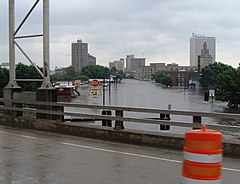 Looking towards downtown Cedar Rapids, Iowa, on June 12 | |
| Date | June 7 - Ongoing |
|---|---|
| Deaths | 1 Death |
| Property damage | TBD |
Severe flooding in Iowa led to evacuations of many homes. In eastern Iowa along the Iowa River and Cedar River, flooding is expected to exceed that of the Flood of 1993.[19] Flooding also forced the closure of a number of roads throughout the state, reaching the point where travel was not advised in some parts of the state.
On Monday, June 9 the Upper Iowa River in Decorah flooded when a levee was breached. Up to 6 inches (152 mm) of rain had fallen in the 48 hours prior. The water flooded parts of the lower campus of Luther College, damaging athletic fields and the Regents Center. Winneshiek County officials called this the worst flood to occur in Decorah since the current levee system was put in place in the 1940s.[20][21] Other portions of the city were flooded. For a time, worries of losing the sanitary sewer system led to a 'please don't flush' order; as of Friday, 13 June, 2008, this order was withdrawn, but pleas for careful use remain in effect.[22] This article also alludes to a difficult cleanup facing Decorah as well as Winneshiek County.

Further downstream on the Upper Iowa, in the small historic unincorporated area of Dorchester, severe flooding was experienced. In particular, a trailer court sustained major damage.[23]
Along the Mississippi River, flood waters were reaching near record levels. In Burlington, the Mississippi reached three different crests, before hitting 22.3 feet (6.8 m) on June 10, the fourth highest stage in the city's history, as of June 15, the expected crest was supposed to be around the 25.8-foot (7.9 m) mark, which would make it the second worst flood in the city's history, surpassing 1993 by 0.7 feet (0.21 m)* this caused the Burlington Steamboat Days to cancel, and close up three days early, the first such occurrence that the festival has closed more than one day early since its inception in 1962. Severe flooding caused the city to close off the entire section of the riverfront, from Main Street, to the riverfront. By the morning of June 15, several streets within the city had been closed off, including the entire length of Front Street, a section of Main Street, between Division Street, and Jefferson Street, a section of Mill Dam Road, Tama Road, and all of its side roads, and County Highway 99. U.S. Highway 61, five miles (8 km) south of the city had been closed on the morning of June 13 due to the rising waters of the Skunk River.
Along the upper Turkey River, the historic towns of Spillville and Fort Atkinson experienced significant flooding, with damaged roads and bridge approaches.[24] Further downstream, portions of Elkader were under water; the river had retreated by Thursday, June 12.[25]


In Cedar Rapids, officials were readying residents and downtown business owners to evacuate as the Cedar River threatened to spill over a levee. The river was expected to top the levee June 11, prompting a mandatory evacuation of downtown.[26] All of the bridges over the Cedar River in downtown Cedar Rapids were closed at 8:00 pm CDT (0100 UTC) on June 11.[27] On June 12, a levee broke, a railroad bridge owned by the Cedar Rapids and Iowa City Railway was swept away along with loaded rail cars, 100 city blocks were submerged downtown, and 10,000 people were evacuated.[28] In Waterloo, fast-moving water swept away a railroad bridge used to transport tractors from a John Deere factory to Cedar Rapids. It also prompted the city to shut its downtown and close five bridges.[26] The Black Hawk County Emergency Management Agency recommended the evacuation of the Cedar Terrace Neighborhood in Southeast Waterloo on June 10.[29] Because of the severe flooding in east-central Iowa, officials with U.S. Postal Service's Des Moines-based Hawkeye District suspended all Retail, Post Office Box and Mail Caller Services at the Waterloo Main Post Office.[30]
On June 12, a mandatory evacuation was issued for the Normandy Drive area of Iowa City.[31] An evacuation of two streets in Coralville was also issued, with the expectations of completing it by 5:00 pm CDT (2200 UTC) on June 12.[32] One person died in the Iowa flooding.[33] A section of Interstate 80 was closed in Cedar County due to flooding. [34]
The small town of Palo, just upstream from Cedar Rapids, and home of Iowa's only nuclear power plant, underwent a mandatory evacuation. As of June 13, the town remains under water.[35]
At 3:43am on the morning of June 14, the National Weather Service in Des Moines Iowa issued a Flash Flood Warning for the City of Des Moines due to a 50-foot (15 m) wide levee breach along the Des Moines River in Des Moines near Birdland Park between 6th Avenue and New York Avenue.
In the evening of June 14, a levee along the Iowa River near Oakville, Iowa failed, causing the swollen waters to rampage through, two days before the mandatory evacuation deadline in the town of Oakville. This also caused evacuation in the Huron Township area. Also, during that same time, an area of the city of Burlington, Iowa was evacuated, along Tama Road, due to a levee problem along the swollen Mississippi River, the levee began to bulge, and was threatening to fail by mid afternoon, by nightfall, it was still holding, but hopes were not high that it would remain intact, this caused Des Moines County to issue an evacuation order for all residents of the county that live east of County Highway 99. By the morning of June 15, the entire length of County Highway 99 within Des Moines County had been closed, by the morning of June 16, three more bulges were discovered along the levee, prompting workers to state that it was no longer a question of if, but when the levee would fail. On June 16, Cedar, Jones, Louisa, Muscatine, Polk, and Winneshiek Counties were approved for federal individual assistance.[36]
Michigan
| Date | June 7 - Ongoing |
|---|---|
| Deaths | 8 Deaths |
| Property damage | TBD |
Several tornadoes touched down in southern Michigan and flooding led to evacuation of many homes. At least eight people died, due to a combination of blowing debris, flooding, and infrastructure failures. On June 14th a State of Emergency is declared for the counties of Allegan, Eaton, and Mason. In days leading up to the State of Emergency, 8 to 11 inches (280 mm) of rain has fallen and winds have been recorded at 98 miles per hour across the area. Officials in Allegan County are expecting to spend nearly $700,000 to repair collapsed roads. More than 50 roads in Mason County are closed due to severe damage, as well as several miles of US-10 and US-31. In the City of Ludington damage to the city's public utilities has left many without drinking water and sewage contamination in the area. [37] [38] [39] [40]
Minnesota
Approximately 75 homes in Preston, Minnesota suffered water damage from excessive rainfall. Some residents were evacuated in Hayfield, Minnesota after the Zumbro River flooded. The Cedar River also flooded which threatened to cause problems in Austin, Minnesota. One man died when his vehicle plunged into a flooded creek near Albert Lea.[41]
Missouri
| Date | June 10 - Ongoing |
|---|---|
| Location | Clark, Lincoln, St. Charles |
| Deaths | 0 Deaths |
| Property damage | TBD |
The deluge of storms led to a quick rise of water on the Mississippi River which saw water crest ten feet above flood stage in Hannibal, Missouri on June 10. The National Weather Service predicted that the flood stage could be higher in the next two weeks. Most of the towns near the river are protected by levees, but outlying areas are vulnerable to flooding.[26]
The town of Winfield was flooded when a levee burst.
Wisconsin
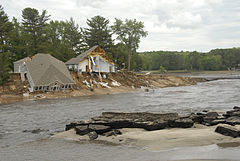 Dell Creek Breach of Lake Delton | |
| Date | June 7 - Ongoing |
|---|---|
| Location | Adams, Calumet, Columbia, Crawford, Dane, Dodge, Fond du Lac, Grant, Green, Green Lake, Iowa, Jefferson, Juneau, Kenosha, Lafayette, La Crosse, Marquette, Milwaukee, Monroe, Ozaukee, Racine, Richland, Rock, Sauk, Sheboygan, Vernon, Walworth, Washington, Waukesha and Winnebago counties.[42] |
| Deaths | 1 Death |
| Property damage | TBD |
On June 7, at least six confirmed tornadoes touched down in multiple counties, as an effect of the strong winds of the daily storms.[43]
Wisconsin Governor Jim Doyle declared a state of emergency in thirty counties on June 9 due to the flooding. FEMA inspectors are due to examine areas that suffered the most damage.[42]
Continued heavy rains in the Wisconsin Dells led to the Dell creek bypassing the dam holding Lake Delton. On June 9, water rushing out of the lake eroded a section of County Highway A and washed away three homes and tore apart several others. The lake is now nearly empty and the escaping flood water has created a new channel for the Wisconsin River about a quarter mile away from the dam. [44][45] Wisconsin National Guard engineers began repairs on the dam the same day, but with the breach being about 400 feet (120 m) wide, the repairs are not expected to be completed for over a year.[46] However, as Governor Jim Doyle called the lake critical to the $1 billion Wisconsin Dells tourism industry, he said the Department of Natural Resources was trying to figure out how to get the water flowing in the man-made lake. Already, there are tourists who had made summer reservations at the lake’s twenty resorts who have been canceling their reservations.[44] The response of the local businesses have been varied. The Delton Oaks Resort, a 60-year operation, will be closing. Meanwhile, the iconic Wisconsin Dells boat tours are reopening despite the low water level. [46] The Tommy Bartlett Show is going to continue, though the waterskiing aspect will be discarded at least until the lake is refilled. [47][48][49]
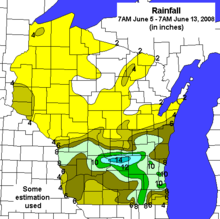
In southwestern Wisconsin, the Kickapoo River rose several feet above flood stage, destroying most of the village of Gays Mills. Gays Mills had already been badly flooded in the August 2007 floods. Officials said Kickapoo River flood damage in Vernon County likely will exceed the $60 million damage caused by the August 2007 floods, and already the water is two feet higher than the high water mark of a historic 1978 flood.[50] In the early morning of June 9, 150 residents in the village of 625 were forced to evacuate.[44] Ontario, Hillsboro, La Farge, and Viola were also severely flooded, much worse than in August 2007. The county took an average of 9 inches (230 mm) of rain over the second weekend, causing mudslides and closing over 100 roads in Vernon, but the rain relented on Monday, June 16th. More thunderstorms, and more severe flooding, is expected in both Vernon and Crawford counties later this week. All the nearby dams have held, though many have sustained damage.[50]
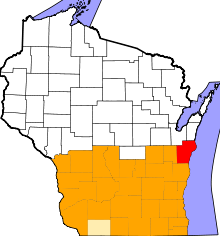
Westbound lanes of Interstate 94 were closed between Johnson Creek and Lake Mills on June 10, 2008 at 7 PM because of the rising Rock River.[52] Eastbound lanes of Interstate 90/Interstate 94 were closed between WIS 82 in Juneau County and WIS 33 west of Portage. Also, Interstate 39 was closed in two places: Northbound at its interchange with I-90/94 and WIS 78, and southbound between WIS 82 and WIS 33. The closure of I-94 westbound in Jefferson County was extended eastward to WIS 83 in Waukesha County.[53] The closure of the interstates around Portage were extended southward to US 151 east of Madison.[54][55]
The first reported fatality due to flooding in the state was confirmed June 14 in Waukesha County. 68-year-old Robert Schaf was found near his car on a flooded road in the town of Summit. Authorities report he died after being stranded on a flooded road, and was found in at least three feet of water.[56]
Flooding has also affected the communities on the Baraboo River. The town of North Freedom had all but one road into town closed because of flooding. The flooding forced the closure of the Mid-Continent Railway Museum.[57][58]
On June 14, federal disaster aid from FEMA was authorized under a major disaster declaration issued for the state by President Bush. Federal funding is available to affected individuals in Columbia, Crawford, Milwaukee, Sauk, and Vernon counties.[59] Continuing damage surveys were conducted, especially in the southeast, and Wisconsin's inhabitants were reassured that other counties would be allowed to receive assistance. [60] Richland and Racine counties were declared disaster areas on June 16.[61] On June 18, the President put five more counties under disaster area status, allowing Dodge, Green, Waukesha, Washington, and Winnebago. At the time of the announcement, the first 7 counties had already recieved almost $38,000 in FEMA aid.[62]
The rainfall in southeastern Wisconsin was anywhere from 6 to 12 inches in the string of thunderstorms.[62] Waukesha County had up to 8 inches in certain areas. As of June 19, municipal estimates for Waukesha County was $87.7 million, $3.2 million more than earlier in the week, though the total remains fluid.[63]
See also
- 2007 Midwest flooding
- June 2008 tornado outbreak sequence
- March 2008 Midwest floods
- Floods in the United States until 1900
- Floods in the United States: 1901-2000
References
- ^ "Midwest Flooding - American Red Cross Issues Appeal For Disaster Relief Fund". News-Sentinel. 2008-06-14. Retrieved 2008-06-15.
- ^ "Mississippi Surges Over Nearly a Dozen Levees". The New York Times. 2008-06-20. Retrieved 2008-06-21.
- ^ "Illinois Flooding". WIFR. 2008-06-11. Retrieved 2008-06-14.
- ^ http://my.barackobama.com/page/community/post/stateupdates/gG5n2J
- ^ http://www.foxnews.com/story/0,2933,367142,00.html
- ^ "Ill. levee breaches force small town's evacuation". Chicago Tribune. 2008-06-18. Retrieved 2008-06-18.
{{cite web}}: Italic or bold markup not allowed in:|publisher=(help) - ^ Disaster Assistance Center Locations. Indiana State Department of Homeland Security. Accessed 14 June 2008.
- ^ http://www.insideindianabusiness.com/newsitem.asp?ID=29796
- ^ "WTHR - Indianapolis News and Weather - One dead, one missing in Indiana flooding". Retrieved 2008-06-14.
- ^ "WTHR - Indianapolis News and Weather - Flooding prompts emergency declarations". Retrieved 2008-06-14.
- ^ "FOXNews.com - Tornadoes, Lightning, Floods Kill 8 From Midwest to Atlantic - Local News". Retrieved 2008-06-14.
{{cite web}}: Text "National News" ignored (help); Text "News Articles" ignored (help); Text "US News" ignored (help) - ^ "Flood disaster list grows". Retrieved 2008-06-14.
{{cite web}}: Text "IndyStar.com" ignored (help); Text "The Indianapolis Star" ignored (help) - ^ CTV.ca News Staff. "Southern Indiana braces for flash flooding". CTV.ca. Retrieved 2008-06-08.
- ^ The Republic. "CRH Communications, Saturday Update". The Republic. Retrieved 2008-06-15.
- ^ FEMA map dated 06/19/08 -- 09:20 PM EDT [1]
- ^ http://www.insideindianabusiness.com/newsitem.asp?ID=29796
- ^ "1 Dead, 1 Missing In Indiana Flood - Indiana News Story - WRTV Indianapolis". Retrieved 2008-06-14.
- ^ "Denied:1up! Software". Retrieved 2008-06-14.
- ^ Iowa City Press-Citizen. "Officials: Flood of 2008 to be worse than Flood of '93". Iowa City Press-Citizen. Retrieved 2008-06-10.
- ^ "News Article - Luther College". Retrieved 2008-06-14.
- ^ Sarah Strandberg, '"Dike Breach causes flooding at Luther", Decorah Newspapers, retrieved June 13, 2008
- ^ UPDATE: Latest flood information (Friday 10 a.m.), Decorah Newspapers, retrieved June 13, 2008
- ^ "Mobile homes destroyed in Dorchester"], Waukon Standard (Waukon, Iowa), June 11, 2008, p.1 online version, retrieved June 15, 2008M
- ^ Sarah Strandberg, "Heavy rains send Upper Iowa to historic level; Spillville and Fort Atkinson also hit with massive flooding" , Decorah Newspapers, retrieved June 13, 2008
- ^ "Elkader Completes First Round of Home Inspections". KCRG-TV, retrieved June 13, 2008
- ^ a b c "Mississippi River floods could be worst in 15 years". CNN. 2008-06-10. Retrieved 2008-06-10.
- ^ "2nd Ave Bridge to Close by 8:00pm". KCRG-TV. 2008-06-11. Retrieved 2008-06-11.
- ^ "Cedar River blasts records; residents flee; rail cars fall". The Des Moines Register. 2008-06-12. Retrieved 2008-06-11.
- ^ "Recommended Evacuation of SE Waterloo Neighborhood". KCRG-TV. 2008-06-10. Retrieved 2008-06-10.
- ^ "Flood Forces Waterloo Post Office to Suspend All Retail Operations". KCRG-TV. 2008-06-11. Retrieved 2008-06-11.
- ^ "Mandatory Evacuation for Normandy Drive in Iowa City". KCRG-TV. 2008-06-12. Retrieved 2008-06-12.
- ^ "MANDATORY EVACUATION: Two Streets in Coralville Told to Leave by Morning". KCRG-TV. 2008-06-12. Retrieved 2008-06-12.
- ^ "Flash Floods Inundate Wisconsin Town, Homes Washed Away; Heat Roasts East". Fox news. 2008-06-10. Retrieved 2008-06-10.
- ^ "Cedar County section of I-80 to close at 8 p.m. tonight". The Gazette. 2008-06-12. Retrieved 2008-06-12.
- ^ "Flood waters isolate Palo", Gazette Online, retrieved June 13, 2008
- ^ "Six More Counties Receive Federal Assistance". KCRG-TV. 2008-06-16. Retrieved 2008-06-16.
- ^ "wzzm13.com". Retrieved 2008-06-14.
{{cite web}}: Text "Governor Granholm Declares State of Emergency in Two West Michigan Counties" ignored (help); Text "Grand Rapids, MI" ignored (help) - ^ "wzzm13.com". Retrieved 2008-06-14.
{{cite web}}: Text "Eight inches (203 mm) of rain fall on lakeshore, roads washed out" ignored (help); Text "Grand Rapids, MI" ignored (help) - ^ "wzzm13.com". Retrieved 2008-06-14.
{{cite web}}: Text "Grand Rapids, MI" ignored (help); Text "Hoekstra to tour counties hit by severe weather today" ignored (help) - ^ "wzzm13.com". Retrieved 2008-06-14.
{{cite web}}: Text "Grand Rapids, MI" ignored (help); Text "Mason County cleanup continues after devastating storm" ignored (help) - ^ "kare11.com". Retrieved 2008-06-14.
{{cite web}}: Text "Frantic sandbagging in Austin as river nears crest Thursday" ignored (help); Text "Twin Cities, MN" ignored (help) - ^ a b Novak, Bill (2008-06-11). "FEMA to view flood damage; state of emergency in 30 counties". Wisconsin State Journal. Retrieved 2008-06-12.
{{cite news}}: Check date values in:|date=(help) - ^ "Tornadoes of June 7, 2008". NOAA's National Weather Service Weather Forecast Office. Retrieved 2008-06-16.
- ^ a b c "Lake Delton, Wis. / Floods wipe out lake homes at Dells". TwinCities.com. Retrieved 2008-06-16.
- ^ Romell, Rick (2008-06-09). "Swollen by rain, Lake Delton nearly empties, wrecking homes, damaging tourism hopes". Milwaukee Journal-Sentinel.
{{cite news}}: Italic or bold markup not allowed in:|publisher=(help); Unknown parameter|coauthors=ignored (|author=suggested) (help) - ^ a b "Engineers Assess Lake Delton Flood Damage". WISN Milwaukee. Retrieved 2008-06-16.
- ^ Foley, Ryan (2008-06-09). "Water washes away homes, forces evacuations in Wisconsin". New York Times. Retrieved 2008-06-10.
- ^ Torriero, E. A. (2008-06-11). "In Wisconsin, the great lake robbery". Chicago Tribune.
{{cite news}}: Italic or bold markup not allowed in:|publisher=(help) - ^ Associated Press video via The Milwaukee State-Journal: "The show must go on"
- ^ a b "Heavy rains flood county: Kickapoo River swallows towns". Vernon County Broadcaster. Retrieved 2008-06-16.
- ^ FEMA map
- ^ WKOW Madison. Interstate 94 to close westbound at Johnson Creek. June 10, 2008.
- ^ "Tornadoes, flash floods spread misery in state". Milwaukee Journal Sentinel. Retrieved 2008-06-13.
- ^ "National Weather Service Watches Warnings and Advisories". Retrieved 2008-06-13.
- ^ "50 to 60 miles of interstate closures as Baraboo River rises". Wisconsin State Journal. Retrieved 2008-06-13.
- ^ "Officials probe flood death". The Waukesha Freeman. Retrieved 2008-06-16.
- ^ "Welcome to Mid-Continent - NEWS BULLETIN UPDATE". Retrieved 2008-06-11.
- ^ "North Freedom: Historic Flood". WMTV. 2008-06-11. Retrieved 2008-06-11.
{{cite news}}: Check date values in:|date=(help); Cite has empty unknown parameter:|1=(help) - ^ "FEMA aid granted to Vernon, other Wisconsin counties due to flooding". Vernon County Broadcaster. Retrieved 2008-06-16.
- ^ "Five Counties Declared Disaster Areas". msnbc.com Broadcaster. Retrieved 2008-06-16.
- ^ "Bush Declares Richland, Racine Counties Disaster Areas". msnbc. Retrieved 2008-06-19.
- ^ a b "FEMA Declares 5 More Counties Disaster Areas". wisn.com. Retrieved 2008-06-19.
- ^ "An official disaster". The Waukesha Freeman. Retrieved 2008-06-19.
External links
- Associated Press. "Coast Guard Called in to Rescue Flooded Indiana Residents". Fox News. Retrieved 2008-06-08.
- Associated Press. "Three drown in record Midwest flooding". MSNBC. Retrieved 2008-06-08.
- Associated Press, Indy 6 News. "Severe Flooding Grips Portion Of State". Indy 6 News. Retrieved 2008-06-08.
{{cite web}}: CS1 maint: numeric names: authors list (link) - Associated Press. "Storms Trigger Deadly Floods". Fox News. Retrieved 2008-06-08.
- Assoicated Press. "Engineers Watch Wisconsin Dams After Collapse". Fox News. Retrieved 2008-06-10.
- Articles to be merged from June 2008
- Current events
- Floods in the United States
- 2008 floods
- 2008 in the United States
- Cedar Rapids, Iowa
- Natural disasters in Illinois
- Natural disasters in Indiana
- Natural disasters in Iowa
- Natural disasters in Michigan
- Natural disasters in Minnesota
- Natural disasters in Missouri
- Natural disasters in Wisconsin
